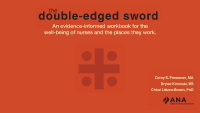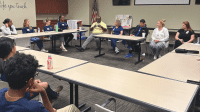Implement the four pillars to reduce burnout.
Takeaways:
- Emotional intelligence (EI) promotes considering our own and others’ emotions before responding to conflict
- In nursing, can elevate professional practice and help combat burnout.
- With routine EI practice and in-the-moment application, nurses can develop healthy relationships and create personal balance.
Over half of physicians and one-third of nurses in the United States experience burnout symptoms such as cynicism or compassion fatigue. Emotional intelligence (EI) can be an effective tool for preventing burnout among healthcare professionals.
EI promotes considering our own and others’ emotions before responding to conflict. Emotion regulation and emotional self-awareness, key EI factors, are specifically cited to help combat burnout. Mayer and Salovey’s original EI definition took shape through work–life application by Goleman in the 1990s. This ongoing application can be translated to healthcare through four emotion-regulating pillars—self-awareness, self-management, social awareness, and relationship management—designed to support healthy relationships and personal balance. Specifically, nurses can use EI as a burnout prevention tool when facing professional dilemmas.
This article will review the four pillars following labor and delivery nurse Jaundi Crown* and her patient Mrs. Salamanca.
EI in practice
Jaundi Crown is a labor and delivery nurse in a rural critical access hospital. She’s assigned to Mrs. Salamanca, a 36-year-old patient who is Gravida 10 Para 6 and recovering from a complicated vaginal delivery and postpartum hemorrhage that required blood transfusions. Her infant was transferred to a neonatal intensive care unit 2 hours away. This delivery was similar to her previous ones. Mrs. Salamanca, who has Type 2 diabetes and is a member of the Seneca Nation, lives on a local reservation among her relatives. She follows a traditional herbal regimen recommended by a known community herbalist in combination with insulin as prescribed by her primary care provider.
Dr. Cole, the inpatient obstetrician/gynecologist overseeing Mrs. Salamanca’s care, asks Jaundi to prepare consent for tubal ligation and accompany him to discuss the decision with the patient. Mrs. Salamanca and her spouse are quiet during the discussion and reluctantly sign the consent. Later, Jaundi finds Mrs. Salamanca crying with her grandmother, who explains that sterilization procedures jeopardize Seneca Nation’s sovereignty and that she forbids it. Mrs. Salamanca explains that she doesn’t want a tubal ligation or medical birth control because she believes they will harm her in the afterlife. When Jaundi calls Dr. Cole, he’s unsupportive. He says that having another child would be suicide for Mrs. Salamanca and orders Jaundi to move forward with scheduling the procedure.
Self-awareness
Self-awareness refers to being conscious of where our personal emotional reactions come from and what experiences (educational or experiential) contribute to them. Find a quiet space and take a few minutes to perform this crucial EI step. Consider journaling or using a brainstorming map to connect key moments in time related to an identified emotion. This isn’t an exercise you’ll present to others, so perform it in whatever way feels comfortable to you—through undocumented thought or by putting pen to paper.
Jaundi spends 5 minutes in the locker room in quiet, private thought about the situation. As a nurse, she’s driven to advocate for her patients; however, in this case, advocating is a double-edged sword. Initially, Jaundi agrees with Dr. Cole because she’s seen first-hand how consequential Mrs. Salamanca’s deliveries are, but she also realizes that upholding spiritual beliefs is essential for quality of life.
This is Jaundi’s first interaction with a member of the Seneca Nation, but she knows that if she faced the same medical concern, she would choose tubal ligation because her religious and cultural beliefs don’t dictate otherwise. In addition, Jaundi is intimidated by Dr. Cole and wants to maintain a healthy working relationship. However, she remembers from nursing school that when conflict exists between religious beliefs and a recommended medical course, the patient, not the nurse or physician, should make the decision.
When Jaundi returns to the unit, she reviews the hospital’s policy on engaging the ethics committee and decides to ask for a consultation. When she completes the request, she explains what happened, using the patient’s words, and marks the issue as moderately urgent, knowing the surgery isn’t scheduled immediately. Jaundi then assures Mrs. Salamanca during bedside handoff that the healthcare team will be working with her during this trying time.
Self-management
Self-management depends on the individual or situation. Tactics include self-talk, support group discussion, exercise, controlled breathing, and self-affirming activities. In the moment, use self-talk to encourage confident forward movement. Taking a few breaths before responding can help you suspend judgement.
When discussing the matter with other involved staff and supervisors, remember to follow Health Insurance Portability and Accountability Act laws. Consider contacting your organization’s employee assistance programs for counseling, but be sure to omit any patient identifiers. In addition, review professional organization guidelines and published evidence-based research.
Jaundi is anxious about her next shift and can’t sleep. She’s concerned that Dr. Cole will be angry and wonders what facing the ethics committee will be like. To help alleviate her anxiety, Jaundi researches patient rights and nursing advocacy online, finding support from The Joint Commission (TJC) and the American Nurses Association (ANA). A number of TJC standards address patients’ rights. For example, Standard RI.01.01.01 states that “the organization respects the patient’s cultural and personal values, beliefs, and preferences.” The ANA’s Nursing: Scope and Standards of Practice includes a standard for culturally congruent practice, stating that the registered nurse “respects consumer decisions.”
Feeling more confident, Jaundi is ready for her next shift and to share these findings with the ethics committee. During report, Jaundi is told that the ethics committee will meet in the afternoon and will probably ask her and Dr. Cole to respond to questions about Mrs. Salamanca’s case.
Social awareness
The EI coin has two sides: self and others. Social awareness takes into account how others react to situations and uses those outward emotions to formulate a response. When faced with new or intimidating people, begin by reading the room one person at a time. Nonverbal cues, such as facial expressions, posture, and gestures, are universal and can help you get a sense of how others view the shared situation. This process allows for a calculated response that will resonate with the group via an invisible relational tie.
Also pay attention to your own nonverbal cues. Your facial expressions should match what you’re saying. Sitting up straight and making eye contact shows confidence and professionalism. Make a point to paraphrase what others have said to verify your understanding and use “I” rather than “you” statements.
Jaundi leaves her cellphone in her locker and completes a hand-off report for her patients before leaving her unit to join the ethics committee meeting. She listens carefully and respectfully responds when appropriate, sharing her knowledge of TJC and ANA standards. She sits up straight with her hands folded, making eye contact with each speaker, summarizing points when prompted to respond. Jaundi says she respects everybody in the room and knows that they all have a mutual desire to advocate for Mrs. Salamanca.
The committee votes in favor of Mrs. Salamanca’s decision to refuse the tubal ligation. Dr. Cole adamantly disagrees. While storming off, he says to Jaundi, “This patient’s death will be in your lap, not mine.” Jaundi is more concerned than ever about their working relationship.
Relationship management
Relationship management focuses on building or rebuilding trust with others. Tactics include reflective listening, empathy exercises, and perspective thinking.
Reflective listening involves listening to others fully without interruption and providing a summary of what you’ve heard if a response is prompted. When summarizing, use a calm, nonjudgmental tone.
Empathy exercises, such as reflecting privately on what the person said or how they reacted, will help to enhance the shared experience.
When using perspective thinking, which takes personal reflective time a step further, you consciously put aside personal reactions and thoughts about a situation to focus on another’s possible motivations, intentions, and feelings. Keeping in mind that negative reactions are commonly out of defense rather than intention, this deep thought process promotes healthy relationships rather than excuses the negative actions of others.
None of these exercises need to be discussed aloud, but they can prove mutually beneficial if practiced routinely.
Jaundi leaves the meeting upset that Dr. Cole spoke to her harshly and that she didn’t get to respond. During her drive home, Jaundi turns off her car radio and practices more reflection. She recalls a time in her first year as a nurse when she argued with her charge nurse about an assignment. Jaundi got the last word by yelling at her charge nurse and blaming her for the patient’s poor care. She remembers that the instant satisfaction of having the last word melted into regret. She also recalls that the charge nurse didn’t bring up Jaundi’s outburst again as anticipated, but instead adapted her methods of assigning patients to include the nursing team. Jaundi remembers feeling better about receiving assignments after that and still feels ashamed about how she reacted.
Jaundi decides that she must do everything she can to remain dedicated to her professional relationships. She’s not a physician and didn’t receive the same training as Dr. Cole, so their thought processes will differ. Jaundi thinks about what it would be like to be a physician and have her medical opinion disregarded after years of training. Maybe he was upset that his opinion was overlooked. Perhaps he had a previous experience in which he upheld a patient’s wishes against his medical judgement and later regretted it. Or maybe he experienced a personal loss similar to Mrs. Salamanca’s case.
By the time Jaundi arrives home, her hands have loosened their intense grip on the steering wheel, and she begins to release her reactive anger to the situation. During the next few months, every time Dr. Cole shows any signs of bitterness toward Jaundi, she practices personal reflection and doesn’t react negatively. She decides to make reflective listening a habit, practicing it daily. Dr. Cole never apologizes, but eventually begins to show signs of trust in Jaundi, even requesting her involvement on similar cases. As they continue to work together, a strong bond is formed because of this shared experience.
Keep practicing
Nursing is emotional work, and nurses need to know how to handle inevitable emotional dilemmas. Routinely practicing EI, which can be done in the moment or reflectively, allows nurses to acknowledge the role emotions play in daily work life. Through this practice, nurses can take proactive steps to prevent becoming the next burnout statistic.
*Names are fictitious.
Connie J. Perkins is the founding director of nursing at St. Bonaventure University in St. Bonaventure, New York.
References
American Nurses Association. Nursing: Scope and Standards of Practice. 4th ed. Silver Spring, MD: American Nurses Association; 2021.
Goleman D. Working with Emotional Intelligence. New York City, NY: Bantam; 1998.
Jung Lee H. How emotional intelligence relates to job satisfaction and burnout in public service jobs. Int Rev Admin Sci. 2017;84(4):729-45. doi:10.1177/0020852316670489
Mayer JD, Salovey P. The intelligence of emotional intelligence. Intelligence. 1993;17(4):433-442. doi:10.1016/0160-2896(93)90010-3
Reith TP. Burnout in United States healthcare professionals: A narrative review. Cureus. 2018;10(12):e3681. doi:10.7759/cureus.3681
Skarbaliene A. Emotional intelligence in healthcare. Med Sci Pulse. 2019;13(1):40-2. doi:10.5604/01.3001.0013.1537
The Joint Commission. Patient safety systems (PS). 2021 Comprehensive Accreditation Manual for Ambulatory Care. 2021.


















